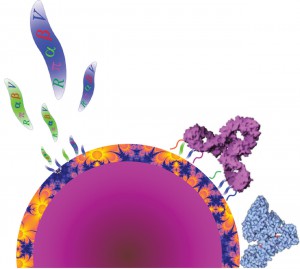Where the Wild Nanoparticles Are

What happens to a nanoparticle when it enters your body? Where does it go, and what does it do when it gets there? Researchers at NC State are helping to answer those questions—they’ve developed a screening tool that will allow scientists to predict where nanoparticles will most likely end up when they enter the human body, and whether or not they may start a wild rumpus when they get there.
A nanoparticle doesn’t just float along untouched when it enters your body. It binds with amino acids and proteins—and these molecules can change the behavior of the nanoparticle by enhancing or reducing characteristics such as toxicity or its ability to deliver drugs to targeted cells. The molecules the nanoparticle binds with also determine where it will go.
Drs. Jim Riviere, Nancy Monteiro-Riviere and Xin-Rui Xiawanted to figure out which biological molecules particular nanoparticles would be most likely to bond with, so they used a series of chemicals to probe the surfaces of various nanoparticles. A nanoparticle’s size and surface characteristics determine the kinds of materials with which it will bond. Once the size and surface characteristics are known, the researchers can then create “fingerprints” that identify the ways that a particular particle will interact with biological molecules. These fingerprints allow them to predict how that nanoparticle might behave once inside the body.
According to Riviere, this work “will give us a better idea of which nanoparticles may be useful for drug delivery, and which ones may be hazardous to humans or the environment.”


